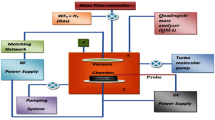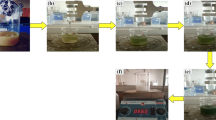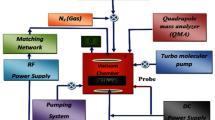Abstract
Natural fibers are naturally supple and have various properties depending upon their chemical composition and physical aspects. Banana fiber is a derivative of the processing of the “banana plant’s pseudostem” (Musasepientum) the current research on the application of natural fiber composites has shown that the physical treatment of fibers improves their adherence to matrices. This works aims to investigate the effect of Cold glow discharge nitrogen plasma treatment on Musa sapientum (banana) fiber to modify the interfacial bonding of fiber-matrix, with cold glow discharge nitrogen plasma treatment 80 W (30 min) and 120 W (30 min) was being utilized. To improve the interfacial strength of banana fibers, induce a sufficient transfer of stress between the matrix and fiber. The cold glow discharge nitrogen plasma treatment 80 W (30 min.) of banana fiber provided the banana fiber reinforced epoxy composite(BFREC) has been found to have improved nearly 81.79% higher interlaminar shear strength, 66.16% higher flexural strength, and 57.54% higher tensile strength. To estimate the morphological characteristics for cold glow discharge nitrogen plasma treated banana fiber and untreated banana fibers performed by FT-IR spectroscopy and (XRD), which showed the improved fiber surface structure, better mechanical and tribological properties can be obtained, broaden the scope of green materials for industrial applications.









Similar content being viewed by others
References
K.G. Satyanarayana, G.C.A. Gregorio, F. Wypych, Biodegradable composites based on lignocellulosic fibers: an overview. Prog. Polym. Sci. 34, 982–1021 (2009). https://doi.org/10.1016/j.progpolymsci2008.12.002
A. Dangi and D. Thakur, “Investigation of tribological properties and fabrication of sisal fiber reinforced polyester composite,” vol. 30, no. October, pp. 25–30, (2019)
R. Gopakumar, R. Rajesh, Experimental study on the influence of fibre surface treatments and coconut shell powder addition on the compressive strength, hardness and tribological properties of sisal fibre-natural rubber composites. Int. J. Enterp. Netw. Manag. 10(1), 23–31 (2019). https://doi.org/10.1504/ijenm.2019.10019583
X. Li, L.G. Tabil, S. Panigrahi, Chemical treatments of natural fiber for use in natural fiber-reinforced composites: a review. J. Polym. Environ. 15(1), 25–33 (2007)
S. Kalia, K. Thakur, A. Celli, M.A. Kiechel, C.L. Schauer, Surface modification of plant fibers using environment friendly methods for their application in polymer composites, textile industry and antimicrobial activities: a review. J. Environ. Chem. Eng. 1, 97–112 (2013)
G. Satyanarayana, J.L. Guimarães, F. Wypych, Studies on lignocellulosic fibers of Brazil. Part I: source, production morphology, properties and applications. Compos. Part A Appl. Sci. Manuf. 38(7), 1694–1709 (2007)
G. Borcia, C.A. Anderson, N.M.D. Brown, Surface treatment of natural and synthetic textiles using a dielectric barrier discharge. Surf. Coat. Technol. 201(6), 3074–3081 (2006)
F. Denes, L.D. Nielsen, R.A. Young, Cold plasma state—a new approach to improve surface adhesion in lignocellulosic-plastics composites. Lignocellul. Plast. Compos. 1, 61–110 (1997)
N. Vandencateele, F. Renier, Plasma modified polymer surface: characterization using XPS. J. Electron Spectrosc. Relat. Phenom. 394–408, 178–179 (2010)
M. Sarikanat, Y. Seki, K. Sever, E. Bozaci, A. Demir, E. Ozdogan, The effect of argon and air plasma treatment of flax fiber on mechanical properties of reinforced polyester composite. J. Ind. Text. 45(6), 1252–1267 (2016)
D. Altgen, G. Avramidis, W. Viol, C. Mai, The effect of air plasma treatment at atnmospheric pressure on thermally modified wood surfaces. Wood Sci. Technol. 50, 1227–1241 (2016)
B. Barra, B. Paulo, C. Alves Junior, H. Savastano Junior, K. Ghavami, Effects of methane cold plasma in sisal fibers. Key Eng. Mater. 517, 458–468 (2012)
E. Sinha, S. Panigrahi, Effect of plasma pretreatment on structural wettability of jute fibre and flexural strength of its composite. J. Compos. Mater. 45, 1791–1802 (2009)
D. Sun, G. Stylios, Fabric surface properties affected by low temperature plasma treatment. J. Mater. Process. Technol. 173(2), 172–177 (2006)
A. Anna Sobczyk-Guzendaa, H. Szymanowskia, W. Jakubowskia, A. Błasińskab, J. Kowalskia, M. Gazicki-Lipmana, Morphology, photocleaning and water wetting properties of cotton fabrics, modified with titanium dioxide coatings synthesized with plasma enhanced chemical vapor deposition technique. Surf. Coat. Technol. 217(25), 51–57 (2013)
Z. Zhou, X. Liu, B. Hu, J. Wang, D. Xin, Z. Wang, Y. Qiu, Hydrophobic surface modification of ramie fibres with ethanol pretreatment and atmospheric pressure plasma treatment. Surf. Coat. Technol. 205, 4205–4210 (2011)
B.S. Kim, M.H. Nguyen, B.S. Hwang, S. Lee, Effect of plasma treatment on the mechanical properties of natural fibre/PP composites, in High performance structures and materials IV. WIT Transactions on built environment. ed. by W.P. De Wilde, C.A. Brebbia (WIT Press, Southampton, 2008), pp. 159–166
E. Bozaci, K. Sever, M. Sarikanat, Y. Seki, A. Demir, E. Ozdogan, I. Tavman, Effects of the atmospheric plasma treatments on surface and mechanical properties of flax fiber and adhesion between fiber–matrix for composite materials. Compos. Part B 45, 565–572 (2013)
American Society for Testing and Materials—ASTM. ASTM C1557–03: Standard test method for tensile strength and young’s modulus of fibers. West Conshohocken, 15:787-796, (2010)
D. Ren, Y. Zixuan, W. Li, H. Wang, Y. Yan, The effect of ages on the tensile mechanical properties of elementary fibers extracted from two sympodial bamboo species. Ind. Crops Prod. 62, 94–99 (2014). https://doi.org/10.1016/j.indcrop.2014.08.014
A. Balaji, B. Karthikeyan, J. Swaminathan, Comparative mechanical, thermal, and morphological study of untreated and NaOH-treated bagasse fiber-reinforced cardanol green composites. Adv. Compos. Hybrid Mater. 2(1), 25–132 (2019)
M. Jacob, S. Thomas, K.K.T. Varughese, Mechanical properties of sisal/oil palm hybrid fiber reinforced natural rubber composites. Compos. Sci. Technol. 64(7–8), 955–965 (2004)
L. Wang, Z.-Q. Xiang, Y.-L. Bai et al., A plasma aided process for grey cotton fabric pretreatment. J. Clean. Prod. 54, 323–331 (2013)
J. Jang, H. Yang, The effect of surface treatment on the performance improvement of carbon fiber/polybenzoxazine composites. J. Mater. Sci. 35, 2297–2303 (2000). https://doi.org/10.1023/A:1004791313979
H. Yasuda, Plasma Polymerisation (Rulla Academic Press Inc., United States of America, 1985), pp. 344–355
C. Fairfield, Optimization of Ion and Electron Properties in IC Packaging Applications,Nordson Corp., United States America, (2000), www.marchplasma.com
C.W. Kan, K. Han, C.W.M. Yuen, M.H. Miao, Surface properties of low-temperature plasma treated wool fabrics. J. Mater. Process. Technol. 83(1–3), 180–184 (1998)
B.K. Goriparthi, K.N.S. Suman, N. Mohan Rao, Effect of fiber surface treatments on mechanical and abrasive wear performance of polylactide/jute composites. Compos. Part A Appl. Sci. Manuf. 43(10), 1800–1808 (2012)
X. Yuan, K. Jayaraman, D. Bhattacharyya, Effects of plasma treatment in enhancing the performance of woodfibre-polypropylene composites. Compos. Part A-Appl. S 35, 1363–1374 (2004)
C. Lu, P. Chen, Q. Yu, Z. Ding, Z. Lin, W. Li, Interfacial adhesion of plasma-treated carbon fiber/poly(phthalazinone ether sulfone ketone) composite. J. Appl. Polym. Sci. 106, 1733–1741 (2007)
J. Jang, H. Yang, The effect of surfacetreatment on the performance improvement of carbon fiber/polybenzoxazine composites. J. Mater. Sci. 35, 2297–2303 (2000)
M. Morra, E. Occhiello, F. Garbassi, Surface characterization of plasma-treated PTFE. Surf. Interface Anal. 16, 412–417 (1990)
N. Dilsiz, E. Ebert, W. Weisweiler, G.A. Kovali, Effect of plasma polymerization on carbon-fibers used for fiber/epoxy composites. J. Colloid Interface Sci. 170, 241–248 (1995)
F.R. Oliveira, L. Erkens, R. Fangueiro et al., Surface modification of banana fibers by DBD plasma treatment. Plasma Chem. Plasma Process 32, 259–273 (2012). https://doi.org/10.1007/s11090-012-9354-3
R. Morent, N. De Geyter, J. Verschuren, K. De Clerck, P. Kiekens, C. Leys, Non-thermal plasma treatment of textiles. Surf. Coat. Technol. 202(14), 3427–3449 (2008)
A. Baltazar-y-Jimenez, M. Bistritz, E. Schulz, A. Bismarck, Atmospheric air pressure plasma treatment of lignocellulosic fibres: impact on mechanical properties and adhesion to cellulose acetate butyrate. Compos. Sci. Technol. 68(1), 215–227 (2008)
E. Bozaci, K. Sever, M. Sarikanat, Y. Seki, A. Demir, E. Ozdogan, I. Tavman, Effects of the atmospheric plasma treatments on surface and mechanical properties of flax fiber and adhesion between fiber–matrix for composite materials. Compos. Part B Eng. 45(1), 565–572 (2013). https://doi.org/10.1016/j.compositesb.2012.09.042
E. Abraham, B. Deepa, L.A. Pothan, M. Jacob, S. Thomas, U. Cuelbar, R. Anandjiwala, Extraction of nanocellulose fibrils from lignocellulosic fibers. A novel approach. Carbohydr. Polym. 86(4), 1468–1475 (2011)
D. Fengel, G. Wegener, In wood—Chemistry, ultrastructure, reactions (Walter de Gruyter, Berlin Germany, 1989)
M.M. Kabir, H. Wang, K.T. Lau, F. Cardona, Effects of chemical treatments on hemp fibre structure. Appl. Surf. Sci. 276, 13–23 (2013)
H. Yang, R. Yan, H. Chen, D.H. Lee, C. Zheng, Characteristics of hemicelluloses, cellulose and lignin pyrolysis. Fuel 86, 1781–1788 (2013)
V. Udeye, S. Mopoung, The production of smokeless charcoal briquettes from banana peeland banana bunch for households use. Wulfenia 22, 454–468 (2015)
M. Akerholm, B. Hinterstoisser, L. Salmén, Characterization of the crystalline structure of cellulose using static and dynamic FT-IR spectroscopy. Carbohydr. Res. 339, 569–578 (2004)
S.Y. Oh, D.I. Yoo, Y. Shin, G. Seo, FTIR analysis of cellulose treated with sodium hydroxide and carbon dioxide. Carbohydr. Res. 340, 417–428 (2004)
F. Carrilo, X. Colom, J.J. Sunol, J. Saurina, Strucutral FTIR analysis and the thermal characterization of lyocell and viscose-type fibers. Eur. Polym. J. 40, 2229–2234 (2004)
S.C. Corgie, H.M. Smith, L.P. Walker, Enzymatic transformations of cellulose assessed by quantitative high-throughput fourier transform infrared spectroscopy (QHT-FTIR). Biotechnol. Bioeng. 108, 1509–1520 (2011)
M.L. Nelson, R.T. O’Connor, Relation of certain infrared bands to cellulose crystallinity and crystal lattice type. Part I. spectra of types I, II, III and of amorphous cellulose. J. Appl. Polym. Sci. 8, 1311–1324 (1964)
M. Wada, T. Okano, Localization of Iα and Iβ phases in algal cellulose revealed by acid treatments. Cellulose 8, 183–188 (2001)
U.J. Kim, S.H. Eom, M. Wada, Thermal decomposition of native cellulose: Influence on crystallite size. Polym. Degrad. Stab. 95, 778–781 (2010)
E. Gumuskaya, M. Usta, H. Kirei, The effects of various pulping conditions on crystalline structure of cellulose in cotton linters. Polym. Degrad. Stab. 81, 559–564 (2003)
M.-C. Popescu, C.-M. Popescu, G. Lisa, Y. Sakata, Evaluation of morphological and chemical aspects of different wood species by spectroscopy and thermal methods. J. Mol. Struct. 988, 65–72 (2011)
Funding
No funding was received by any of the authors on any level for research work to be carried.
Author information
Authors and Affiliations
Corresponding author
Ethics declarations
Conflict of interest
The authors whose names are listed have NO affiliations with or involvement in any organization or entity with any financial interest (such as honoraria; educational grants; participation in speakers’ bureaus; membership, employment, consultancies, stock ownership, or other equity interest; and expert testimony or patent-licensing arrangements), or non-financial interest (such as personal or professional relationships, affiliations, knowledge or beliefs) in the subject matter or materials discussed in this manuscript.
Additional information
Publisher's Note
Springer Nature remains neutral with regard to jurisdictional claims in published maps and institutional affiliations.
Rights and permissions
About this article
Cite this article
Gupta, U.S., Tiwari, S., Sharma, U. et al. Cold Glow Discharge Nitrogen Plasma Pretreatment of Banana Fibre for Improving the Mechanical Characterisation of Banana/Epoxy Composites. J. Inst. Eng. India Ser. D 103, 417–429 (2022). https://doi.org/10.1007/s40033-022-00356-8
Received:
Accepted:
Published:
Issue Date:
DOI: https://doi.org/10.1007/s40033-022-00356-8




